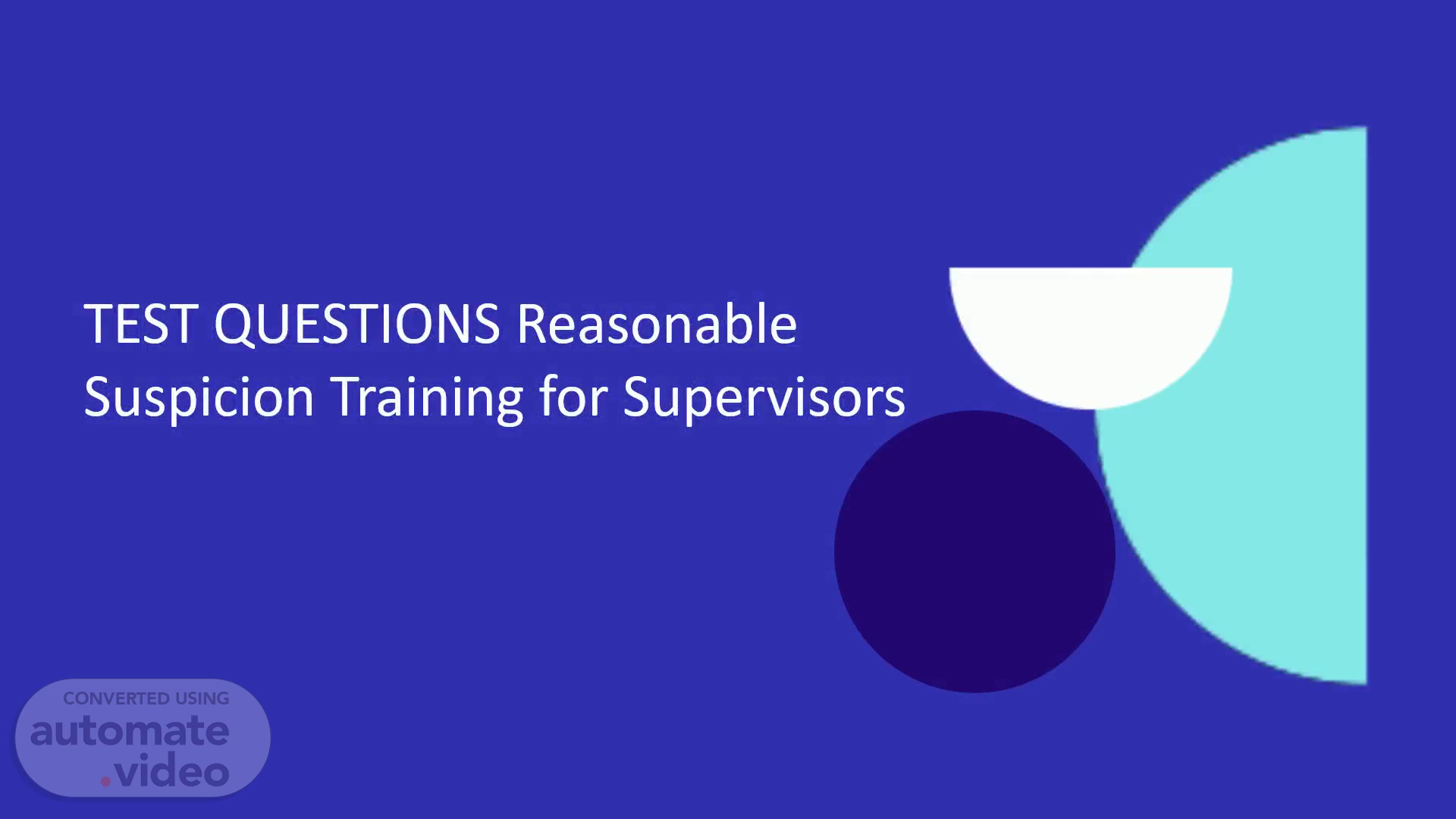
Storyboard Brainstorm Presentation
Scene 1 (0s)
[Audio] Test questions reasonable suspicion training for supervisors.
Scene 2 (7s)
[Audio] Reasonable Suspicion: Helping Managers Fight Workplace Substance Read the question(s) below and answer as requested. Check your answers by reviewing the answer sheet and read the comments related to that question. Answer any question again that you do not score correctly. This series of 35 questions is designed to be educational and questions may not necessarily relate directly to the audio/visual program..
Scene 3 (37s)
[Audio] Q # 01 Read the question(s) below and answer as requested. Check your answers by reviewing the answer sheet and read the comments related to that question. Answer any question again that you do not score correctly. This series of 35 questions is designed to be educational and questions may not necessarily relate directly to the audio/visual program..
Scene 4 (1m 14s)
[Audio] The following is an example of useful and correctly written documentation: " Tom S. arrived twenty minutes late to work today and was witnessed, by several employees, damaging another vehicle while trying to park his car. He was heard yelling obscenities from within car. When I met with him immediately after the incident, I could smell alcohol on his breath." True False.
Scene 5 (1m 42s)
[Audio] Q # 03 THE FOLLOWING IS AN EXAMPLE OF INADEQUATE DOCUMENTATION THAT WOULD BE INADMISSIBLE IN A DISCIPLINARY PROCEEDING, OR FOR USE TO SUPPORT A REQUEST THAT THE EMPLOYEE SUBMIT TO A REASONABLE SUSPICION DRUG TEST: " TOM SMITH ARRIVED AT WORK LATE WITH REPORTS BY OTHERS OF BEING DRUNK. HE SCRAPED A CAR IN THE PARKING LOT AND WHEN CONFRONTED BY ME- AFTER THE INCIDENT- BECAME DEFENSIVE AND IMMATURE LIKE A PERSON WHO HAD SOMETHING TO HIDE. HE DENIED HE WAS DRUNK BUT ADMITTED HE HAD BEEN DRINKING BEFORE MIDNIGHT." TRUE FALSE.
Scene 6 (2m 19s)
[Audio] It is a proven fact that employees who abuse drugs and alcohol are more likely to be injured on the job. True False.
Scene 7 (2m 29s)
[Audio] Not only can a supervisor save a job, if the supervisor has a reasonable suspicion of substance abuse, he or she can save the life of an employee by referring the employee for drug testing. True False.
Scene 8 (2m 44s)
[Audio] When a supervisor suspects an employee has been drinking on the job or using alcohol before coming to work, delays in arranging a reasonable-suspicion test can cause the test to be negative because alcohol detoxifies more rapidly than other substances. True False.
Scene 9 (3m 2s)
[Audio] If the supervisor notices a significant change in an employee's job performance or behavior, this could be an indicator that there is an issue of drug or alcohol abuse. Deterioration of job performance is one of the earliest, primary indicators of a drug or alcohol problem. True False.
Scene 10 (3m 24s)
[Audio] If the employee appears under the influence and refuses to submit to a reasonable suspicion test for drugs or alcohol, making a show of force using other employees is an effective way to gain cooperation. True False.
Scene 11 (3m 40s)
[Audio] If a supervisor knows the employee very well, it is usually appropriate to ask a few personal questions about problems at home or in his or her personal life in order to determine if a drug or alcohol problem exists. Any answer like, "I am seeing my doctor today," or "I am back with my 12-step program," means the supervisor can skip the idea or referring the employee for testing. True False.
Scene 12 (4m 7s)
[Audio] In some drug stores, small plastic breathalyzer tubes are available for purchase that, when activated, will measure one's blood alcohol level when one blows through it. These devices are handy and should be used for prescreening an employee the supervisor thinks may be using alcohol at work. True False 11. When making a referral to testing, the supervisor should appear supportive to his or her employee by sharing personal information about the supervisor's own past experiences with drugs and alcohol. This will make the supervisor a positive role model for the employee. True False.